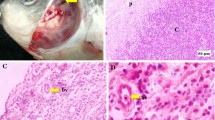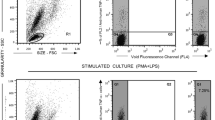Abstract
Monoclonal antibodies are an important tool in the study of botryllid ascidians’ immunology and developmental biology. Here we describe the development of a panel of 38 monoclonal antibodies that are specific to Botryllus schlosseri (Ascidiacea; subfamily Botryllinae) cell surface antigens. Many of these hybridomas recognize (by enzyme-linked immunosorbent assay and immunohistochemistry) epitopes of Botrylloides subpopulations (SP) II and III from the Mediterranean coast of Israel and show, on blood cell smear assays, reactions with subsets of Botryllus circulating blood cells. Fluorescence-activated cell sorting analyses using antibodies positive for botryllid tissues revealed up to 3.6% positive cells. ELISA screenings were performed with 64 new monoclonal antibodies on 5 different individual botryllid ascidian colonies (B. schlosseri, Botrylloides). The positive antibodies in this panel identified a large number of different antigenic determinants, some of which distinguish Botryllus versus Botrylloides colonies, and other, different colonies within these two species, or different cell types within tissues, embryos, and buds of individual colonies. Only 21 monoclonal antibodies tested positive with all colonies. Cross-reactivity with at least one Botrylloides colony was recorded in 49 hybridomas that identified Botryllus cells. This wide panel of monoclonal antibodies is the first such detailed set of monoclonals available for studies on botryllid ascidians.


Similar content being viewed by others
References
Berrill NJ. (1941). The development of the bud in BotryllusBiol Bull 80:169–184
Berrill NJ. (1955). The Origin of the VertebratesLondon, U.K.: Oxford University Press
Burighel P, Schiavinato A. (1984). Degenerative regression of the digestive tract in the colonial ascidian Botryllus schlosseri (Pallas)Cell Tissue Res 235:309–318
Eshhar Z. (1985). Monoclonal antibody strategy and techniques. In: Spring T.A., (ed). Hybridoma Technology in the Biosciences and Medicine, New York, N.Y.: Plenum Press, 3–41
Fagan MB, Weissman IL. (1998). Characterization of a polymorphic proteinBiol Biotechnol 7:204–213
Fazekas de St. Groths, Schneidegger D. (1980). Production of monoclonal antibodies: strategy and tacticsJ Immunol Methods 35:1–21
Lapidot Z, Paz G, Rinkevich B. (2003). Monoclonal antibody specific to urochordate Botryllus schlosseri pyloric glandMar Biotechnol 5:388–394
Lauzon RJ, Ishizuka K, Weissman IL. (1992). A cyclical, developmentally-regulated death phenomenon in a colonial urochordateDev Dyn 194:71–83
Lauzon RJ, Patton CW, Weissman IL. (1993). A morphological and immunohistochemical study of programmed cell death in Botryllus schlosseri (Tunicata, Ascidiacea)Cell Tissue Res 272:115–127
Milkman R. (1967). Genetic and developmental studies on Botryllus schlosseri Biol Bull 132:229–243
Naot Y, Remington JS. (1981). Use of enzyme-linked immunosorbent assays (ELISA) for detection of monoclonal antibodies: experience with antigens of Toxoplasma gondiiJ Immunol Methods 43:333–341
Oka H, Watanabe H. (1957). Colony fusibility in compound ascidians as tested by fusion experimentsProc Jpn Acad Sci 33: 657–659
Rinkevich B. (2002). The colonial urochordate Botryllus schlosseri: from stem cells and natural tissue transplantation to issues in evolutionary ecologyBioEssays 24:730–740
Rinkevich B, Shapira M. (1998). An improved diet for inland broodstock and the establishment of an inbred line from Botryllus schlosseri, a colonial sea squire (Ascidiacea)Aquat Living Re sour 11:163–171
Rinkevich B, Yankelevich I. (2004). Environmental split between germ-cell parasitism and somatic cell synergism in chimeras of a colonial urochordateJ Exp Biol 207:3531–3536
Rinkevich B, Shlemberg Z, Lilker-Levav T, Goren M, Fishelson L. (1993). Life history characteristics of Botrylloides (Tunicata) populations in Akko Bay, Mediterranean coast of IsraelIsr J Zool 39:197–212
Sabbadin A. (1982). Formal genetics of ascidiansAm Zool 22:765–773
Schlumpberger JM, Weissman IL, Scofield VI. (1984a). Separation and labeling of specific subpopulations of Botryllus blood cellsJ Exp Zool 229:401–411
Schlumpberger JM, Weissman IL, Scofield VI. (1984b). monoclonal antibodies developed against Botryllus blood cell antigens bind to cells of distinct lineages during embryonic developmentJ Exp Zool 229:205–213
Scofiled VL, Schlumpberger JM, West LA, Weissman IL. (1982). Protochordate allorecognition is controlled by an MHC-like gene systemNature 295:499–502
Simon-Blecher N, Achituv Y, Rinkevich B. (2004). Protochordate concordant xenotransplantation settings reveal outbreaks of donor cells and divergent life span traits Dev Comp Immunol 28:983–991
Stoner DS, Rinkevich B, Weissman IL. (1999). Heritable germ and somatic cell lineage competitions in chimeric colonial protochordatesProc Natl Acad Sci U S A 96:9148–9153
Acknowledgments
Thanks are due to E. Moiseeva and M. Sigal. This study was supported by a grant from the National Institutes of Health (RO1-DK54762), by the US-Israel Bi-National Science Foundation, and by the Israel Science Foundation.
Author information
Authors and Affiliations
Corresponding author
Rights and permissions
About this article
Cite this article
Lapidot, Z., Rinkevich, B. Development of Panel of Monoclonal Antibodies Specific to Urochordate Cell Surface Antigens. Mar Biotechnol 7, 532–539 (2005). https://doi.org/10.1007/s10126-004-5067-9
Received:
Accepted:
Published:
Issue Date:
DOI: https://doi.org/10.1007/s10126-004-5067-9




